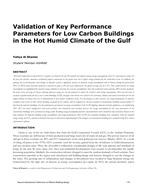Description
All Gulf Cooperation Council (GCC) countries are listed in the top 20 countries for highest annual energy consumption and CO2 emissions per capita. In the past few decades, numerous residential projects constructed in the region have led to higher energy demand for the residential sector. In addition, the growing rate of urbanization and changes in lifestyles caused a significant increase in domestic energy consumption and in Oman, during the period from 2012 to 2018, peak electricity demand is expected to grow at 8% per year compared to the global average rate of 2.5%. This rapid increase in energy consumption has highlighted the need for energy solutions to overcome its excessive consumption. Since the residential sector consumes 48% of total electricity, the main source of energy in Oman, reducing domestic energy use has the potential to reduce the country’s total energy consumption. This research aims to evaluate experimentally the key Low Carbon Building (LCB) strategies and criteria best suited to the economic, climatic and social constraints for the hot humid climate of Oman that can be implemented in their future residential sector. For the purpose of this research, the energy performance of reference exemplar state of the art low carbon buildings available in the country, will be compared to selected examples of conventional buildings located within 15 km from the reference buildings. Six key performance parameters of energy consumption in the LCB; lighting, domestic electronic appliances, air conditioning (HVAC), hot water, refrigerators and wash machine, were monitored and recorded, whereas the energy consumption for the same parameters in the conventional buildings were calculated by energy audit. Building energy consumption patterns and performance were monitored and calculated. Based on the data collected, the domestic building energy consumption and energy performance index (EPI) for residential buildings were calculated. Then the modeled energy saving and CO2 emission reductions that may be achieved by implementing LCB strategies on conventional building were evaluated using IES virtual environment software.
Citation: 2nd Intl Conf: Efficient Bldg Design
Product Details
- Published:
- 2016
- Number of Pages:
- 8
- Units of Measure:
- Dual
- File Size:
- 1 file , 690 KB
- Product Code(s):
- D-ICEB16-24
